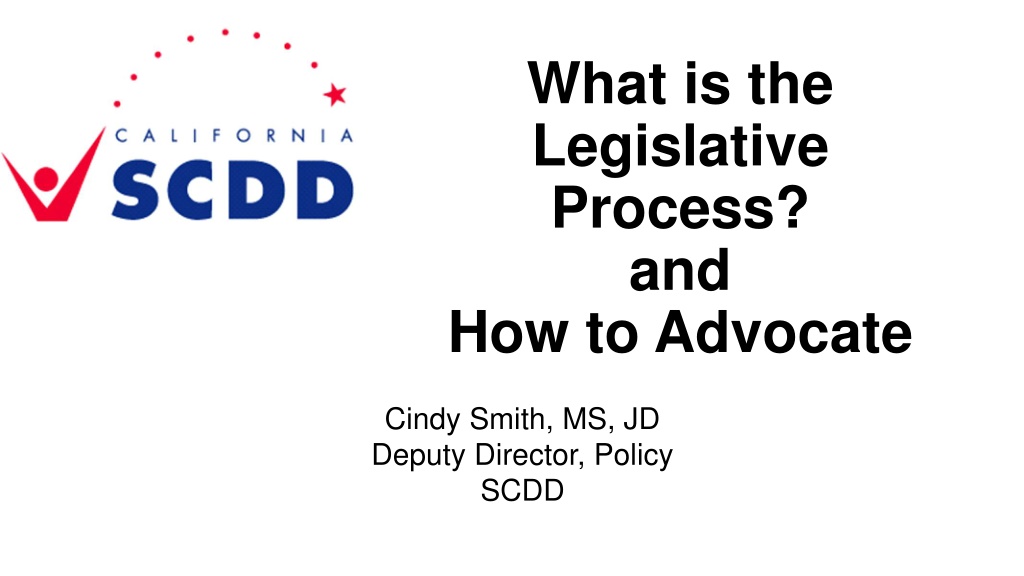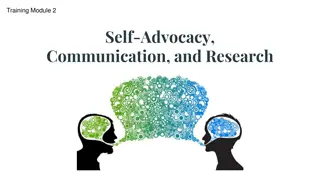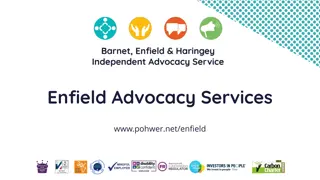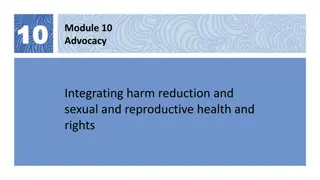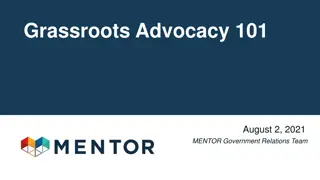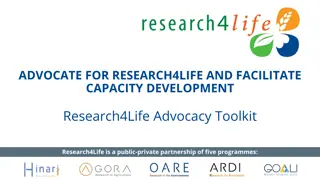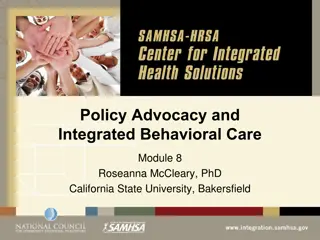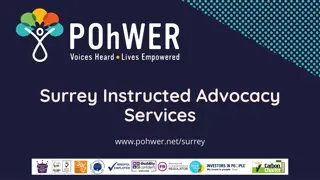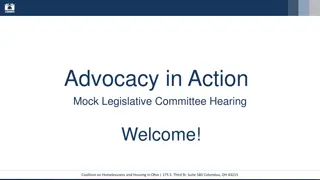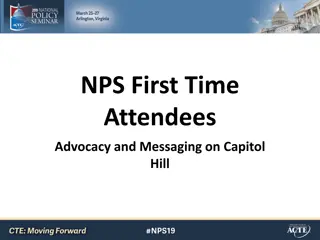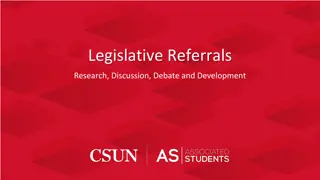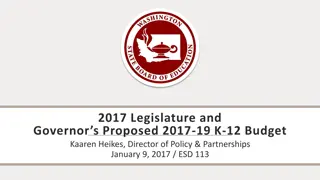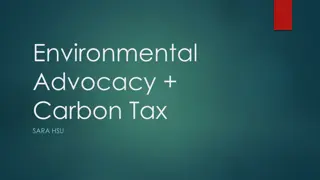Legislative Process & Advocacy for Policy Change
Learn about the legislative process, federal vs. state laws, advocacy strategies, and the impact of the Developmental Disabilities and Bill of Rights Assistance Act on informing policymakers and promoting citizen participation. Understand the interpretation of requirements for advocacy activities under the Act.
Download Presentation

Please find below an Image/Link to download the presentation.
The content on the website is provided AS IS for your information and personal use only. It may not be sold, licensed, or shared on other websites without obtaining consent from the author.If you encounter any issues during the download, it is possible that the publisher has removed the file from their server.
You are allowed to download the files provided on this website for personal or commercial use, subject to the condition that they are used lawfully. All files are the property of their respective owners.
The content on the website is provided AS IS for your information and personal use only. It may not be sold, licensed, or shared on other websites without obtaining consent from the author.
E N D
Presentation Transcript
What is the Legislative Process? and How to Advocate Cindy Smith, MS, JD Deputy Director, Policy SCDD
Federal Law versus State Law The Supremacy Clause of the U.S. Constitution dictates that federal law is the "supreme law of the land." Judges must follow the U.S. Constitution, and federal law. A federal law preempts a state law even when the laws conflict so a federal court may require a state to stop certain behavior it believes interferes or conflicts with federal law. In the absence of a federal law, or when a state law would provide more protections for residents than what is available under existing federal law, state law holds.
The Developmental Disabilities and Bill of Rights Assistance Act states the Council shall implement the State plan by conducting and supporting advocacy, capacity building, and systemic change activities including: (J) INFORMING POLICYMAKERS. The Council may support and conduct activities to provide information to policymakers by supporting and conducting studies and analyses, gathering information, and developing and disseminating model policies and procedures, information, approaches, strategies, findings, conclusions, and recommendations. The Council may provide the information directly to Federal, State, and local policymakers, including Congress, the Federal executive branch, the Governors, State legislatures, and State agencies, in order to increase the ability of such policymakers to offer opportunities and to enhance or adapt generic services to meet the needs of, or provide specialized services to, individuals with developmental disabilities and their families.
The Developmental Disabilities and Bill of Rights Assistance Act states the Council shall implement the State plan by conducting and supporting advocacy, capacity building, and systemic change activities including: (I) COALITION DEVELOPMENT AND CITIZEN PARTICIPATION. The Council may support and conduct activities to educate the public about the capabilities, preferences, and needs of individuals with developmental disabilities and their families and to develop and support coalitions that support the policy agenda of the Council, including training in self-advocacy, education of policymakers, and citizen leadership skills.
Interpretation of DD Act Requirements In 2001, an AIDD memo addressed the prohibition against lobbying with federal funds and the requirement that SCDD can inform policymakers and undertake advocacy. In 2015, when AIDD issued regulations for the DD Act, it stated that the guidance was still applicable. The guidance states that the lobbying prohibitions include: influencing the outcome of a Federal, state or local election or making contributions to political parties; paying any person for influencing the awarding of any Federal contract, grant, or loan ; and influencing the enactment of legislation and related activities.
Interpretation of DD Act Requirements AIDD states in the memo that it believes the Councils can meet their responsibility to inform policymakers under the DD Act and avoid violating the limitations on lobbying by: Using a nonpartisan approach, the Councils can advocate a particular position or viewpoint so long as there is a sufficiently full and fair exposition of the pertinent facts to enable the policymaker to form an independent opinion or conclusion. The Council must refrain from presenting unsupported opinions, distorted facts, inflammatory and disparaging terms, or conclusions based more on strong emotional feelings than on objective factual conclusions. In advising legislators and others concerning adoption of legislation should approach the task in a balanced way, discussing the advantages and disadvantages of the legislation and comparing it with other proposals that may also be under consideration. A nonpartisan approach to informing legislators does not require that the Council be neutral about outcomes for individuals with developmental disabilities. Councils need to demonstrate an unbiased attitude when considering alternatives for meeting the needs of such persons. Councils should emphasize their role as a source of information and advice in helping legislators and other policymakers to identify and evaluate the available alternatives for meeting the needs of individuals with developmental disabilities.
Make-up of U.S. Congress and the CA State Legislature U.S. Congress House of Representatives - 435 Members (with 53 California Members) Senate - 100 Members (with 2 state-wide Members from each state) CA State Legislature Assembly 80 Members Senate 40 Members
General Overview of the Legislative Process The process of the federal or state government by which bills are considered and laws enacted is commonly referred to as the Legislative Process. Both the federal and state legislatures goes through a process with the same basic steps: All legislation begins as an idea. Ideas for legislation can come from a variety of sources, but a Member of Congress or of the CA State Legislature must be the one to introduce the bill. The idea becomes a bill once introduced. The idea for the bill is sent to Legislative Counsel who drafts it in the proper bill format. The draft of the bill is returned to the Member s office for introduction. After a series of readings, hearings, changes known as amendments, the bill moves from Committees to floor votes and ultimately to the Executive Branch for the President or Governor to sign.
Critical Differences in Federal and State Legislative Processes The Member of Congress who introduces the bill is the sponsor of the bill. Other Members of Congress from the same Chamber are known as co- sponsors. In the California Legislature, the Member who introduces the bill is known as the author. Additional members who support the bill are known as co-authors. There are specific deadlines for each step of the California legislative process. If a bill does not meet each deadline, the bill dies. In the U.S. Congress, a bill only dies at the end of the two-year session. There are no other deadlines for when an authorizing bill must move through the legislative process. The President does not have a line-item veto for any type of bill. He can veto the entire bill or sign the bill. The Governor can veto specific items in the budget using a line item veto.
Critical Differences in Federal and State Legislative Processes Funding for programs supported by the federal or state government run on different calendars. The Legislative calendar runs on the calendar year, but the federal fiscal year is from October 1-September 30. The state fiscal year is from July 1-June 30. In the U.S. Congress, a bill does not have to be successfully voted out of one Chamber before moving forward in the legislative process. A bill can move at the same time through the House of Representatives and U.S Senate. In California, bills move through the Chamber they are introduced in before moving to the other Chamber. The U.S. Congress does not take public comment at hearings. Opinions and viewpoints on legislation is conveyed through outreach to offices in advance of informational hearings and mark-ups of bills. The CA State Legislature does take public comment from concerned individuals during hearings. Hearings in California are also where changes to the bills are made.
Federal Process The federal legislative cycle runs for two years starting in odd years in January. The 115thCongress will be sworn in after the November elections. After swearing in, new Leadership and Committee assignments will be made for both the Democrats and Republicans. There are two types of federal legislation. Authorizing legislation that creates or revises current federal programs. Appropriations legislation that funds the federal government and its federal programs. Members of Congress can introduce legislation at any time during the two years. With one exception, there are no legislative deadlines on legislation during a two-year session.
Federal Process The exception is that every year by October 1st, U.S. Congress must pass bills to fund the government known as appropriations bills. The bill that funds most programs impacting people with disabilities is the Labor-Health Human Services-Education and Related Agencies bill. This bill also funds SCDD. If the federal government and its programs are not funded by October 1st, then the government closes until the bill is passed. Authorizing bills are frequently included as policy riders with funding bills. The change to policies and programs literally rides along with the funding bill. Federal Legislative Process: https://www.congress.gov/legislative- process
SCDDs Positions on Federal Legislation SCDD cannot take a position on federal legislation that is different than the National Association of Councils on Developmental Disabilities (NACDD). SCDD expresses its position through NACDD. NACDD is the lobbyist that represents all Councils with the U.S. Congress and the federal agencies. NACDD decides its policy agenda and positions based on two Board of Director approved agendas and the input of NACDD s Public Policy Committee. SCDD serves on NACDD s Public Policy Committee and provides input to NACDD through the Policy Committee. SCDD s role is to educate Members of Congress on the issues that NACDD has taken a position based on requests from NACDD.
State Legislative Process California runs on a two-year legislative session starting in odd years. The new Legislature will be sworn in after the November elections in December. After swearing in, new Leadership and Committee assignments will be made for both the Democrats and Republicans. The State Legislature has a firm set of deadlines that must be met each year for bills to move through the legislative process. There are two types of state legislation. Authorizing legislation that creates or revises current state programs. Budget legislation that funds the state government and state programs.
SCDDs Positions on State Legislation SCDD cannot work on policy issues that are not directly related to SCDD s approved state plan. SCDD also has a Council approved legislative platform that serves as the foundation for SCDD s policy activities. SCDD decides its policy agenda and priorities based on input from SCDD s Employment First Committee (EFC) and Legislation and Public Policy Committee (LPPC). The EFC and LPPC provide recommendations to the Council to approve for SCDD s positions. EFC and LPPC will be making recommendations on priorities to the Council tomorrow to begin work for the next legislative session. At times between meetings, SCDD s Chair uses delegated authority to take positions between Council meetings when timing necessitates an immediate decision.
What Types of Positions Does SCDD Take on Legislation Support (with or without amendments) Watch Oppose (with or without amendments) No Position
How does SCDD divide its policy work? Levels of government: Federal, state, county and city. Headquarters takes the primary lead in working with all federal and state Capitol offices to communicate the Council s positions. Regional offices take the primary lead in working with state District offices (coordinating with Headquarters), county and city offices. It is critical that the Council and staff are speaking with one voice to all offices throughout California for informing and advocating with elected officials to be effective.
Is the U.S. Congress or the Senate in Session? CA Legislative Calendar is at: http://www.legislature.ca.gov/the_state_legislature/calendar_an d_schedules/calendar_schedules.html U.S. Congress Legislative Calendar is at: https://www.congress.gov/resources/display/content/Calendars +and+Schedules
How Do I Find My Member? Official website for information activities of the U.S. Congress is at https://www.congress.gov/ (also to track bills and know daily proceedings) U.S. House of Representative s Directory: https://www.house.gov/representatives U.S. Senate Directory: https://www.senate.gov/general/contact_information/senators_cfm.cfm Official website for information activities of CA State Legislature is at http://leginfo.legislature.ca.gov/ (also to track bills and know daily proceedings) California State Senate Directory: https://www.senate.ca.gov/ California State Assembly Directory: https://www.assembly.ca.gov/ Find Your Legislator is at: http://www.legislature.ca.gov/legislators_and_districts/legislators_and_district s.htm
A few notes before contacting offices: All offices in both the U.S. Congress and the CA State Legislature operate as their own small business. It is best to visit the website of the Member s office and see how they prefer to be contacted. It is not uncommon to work with multiple people in the same office. If you call and ask for the person who covers disability , you will frequently will be contacted with the person who works on health issues. Call and ask for the person who works on education or employment or civil rights or transportation or housing etc. instead of the person that works on disability issues. District office or Capitol office? For policy issues, it is best to contact the Capitol office. The District offices typically work on direct service issues for constituents not the policy issues being currently debated in the Chamber.
How Do I Contact Members of Congress? U.S. Postal Mail - No, it takes too long to arrive at the U.S. Capitol. It goes to an off-site screening facility and takes weeks to arrive at the U.S. Capitol. Calls Yes, just call the Capitol Switchboard at (202) 224-3121 and ask to be connected to your Member of Congress Office. Emails Yes, but calls are still better on critical time-sensitive issues. Generally, Senate email addresses are formatted as firstname_lastname@lastnameofsenator.senate.gov and House email addresses are firstname.lastname@mail.house.gov. Faxes Still work too! Social Media Facebook and Twitter
How Do I Contact Members of CA State Legislature? U.S. Postal Mail - No, it takes too long to arrive at the Capitol. Calls Yes, look at the Member Directory and call the office. Emails Yes, but calls are still better on critical time-sensitive issues. Faxes Still work too! Social Media Facebook and Twitter
Meeting with Legislators Offices Over the next year, SCDD s goal is to ensure that every office in Congress and the State Legislature knows who we are and what we do. That said, there are offices in both the CA Legislature and U.S. Congress that SCDD will prioritize because of the roles of the Members (ex: leadership, members assigned to certain Committees, sponsors of SCDD legislation etc.) or not prioritize (ex: members leaving or retiring). The goal is for every office to see SCDD as a trusted resource for information.
Notes on Meetings with Members Do a little background research on the Member s website to see what might be of interest to them. Bring a packet of materials to the meeting introducing them to the issues you want to discuss. If you can thank the Member or mention something he or she has recently done that you support to start the meeting. Make it clear that you see the Member as a partner in ensuring people with disabilities can learn, work, live in the community etc.
Notes on Meetings with Members Take timing cues from the Member or their staff. Meeting with staff is equally important as meeting with the Member themselves. Be early, and do not take it personally if you or others have to wait for the meeting to start. Be prepared to meet anywhere. If multiple people are attending the meeting, prepare in advance for who is going to cover what talking points in the meeting. Go into a meeting with no more than 2-3 topics of discussion. Share both stories and data.
After the Meeting Follow-up with the office is just as or more important than the meeting. After the meeting send a thank you email, and any additional information that you promised to send to them. Let Cindy know who you met with, the outcomes of the meeting and of any follow-up needed. Ask if you can add the to your Regional or SCDD s statewide list. On a continuing basis, consider items of mutual interest that you can be in touch with them about to share information and resources.
